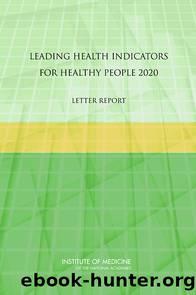Leading Health Indicators for Healthy People 2020: Letter Report by Institute of Medicine of the National Academies

Author:Institute of Medicine of the National Academies
Language: eng
Format: epub
Tags: Health and Medicine
Publisher: NATIONAL ACADEMIES PRESS
Published: 2011-04-28T00:00:00+00:00
TU 1: Reduce Tobacco Use by Adults
According to the American Lung Association (2010), annual smoking prevalence declined by more than 50 percent between 1965 and 2008. Despite that decline, tobacco use is the leading cause of preventable morbidity and mortality in the United States (CDC, 2009a). One in five deaths annually is attributable to tobacco use (CDC, 2008). It is estimated that, in 2009, 69.7 million people in the United States aged 12 or older were current users of tobacco, of whom 58.7 million smoked cigarettes, 13.3 million smoked cigars, 8.6 million used smokeless tobacco, and 2.1 million smoked a pipe (SAMHSA, 2010).
Tobacco use has numerous health consequences. It is related to many types of cancer (bladder, cervical, esophageal, kidney, laryngeal, leukemia, lung, and oral). It is a major cause of cardiovascular disease and chronic lung disease (emphysema and chronic obstructive pulmonary disease), and has negative reproductive and developmental effects (HHS, 2006a). Male smokers are 23 times more likely and women smokers are 13 times more likely to die of lung cancer than their nonsmoking counterparts (HHS, 2004). Risk of stroke doubles for those who smoke compared to those who donât (HHS, 1998), smokers are 20 times more likely to develop peripheral vascular disease than nonsmokers (Fielding et al., 1998), and smokers are two to four times more likely than nonsmokers to develop coronary heart disease (HHS, 1989). âDuring 2000â2004, smoking resulted in an estimated annual average of 269,655 deaths among males and 173,940 deaths among females in the United Statesâ (CDC, 2008).
It is estimated that cigarette smoking results in $97 billion in lost productivity and $96 billion in health care costs each year (CDC, 2008) while the costs of secondhand smoke are more than $10 billion (Behan et al., 2005).
Download
This site does not store any files on its server. We only index and link to content provided by other sites. Please contact the content providers to delete copyright contents if any and email us, we'll remove relevant links or contents immediately.
| Administration & Medicine Economics | Allied Health Professions |
| Basic Sciences | Dentistry |
| History | Medical Informatics |
| Medicine | Nursing |
| Pharmacology | Psychology |
| Research | Veterinary Medicine |
Periodization Training for Sports by Tudor Bompa(7946)
Why We Sleep: Unlocking the Power of Sleep and Dreams by Matthew Walker(6388)
Paper Towns by Green John(4826)
The Immortal Life of Henrietta Lacks by Rebecca Skloot(4274)
The Sports Rules Book by Human Kinetics(4097)
Dynamic Alignment Through Imagery by Eric Franklin(3935)
ACSM's Complete Guide to Fitness & Health by ACSM(3834)
Kaplan MCAT Organic Chemistry Review: Created for MCAT 2015 (Kaplan Test Prep) by Kaplan(3815)
Introduction to Kinesiology by Shirl J. Hoffman(3634)
Livewired by David Eagleman(3547)
The River of Consciousness by Oliver Sacks(3431)
The Death of the Heart by Elizabeth Bowen(3355)
Alchemy and Alchemists by C. J. S. Thompson(3312)
Descartes' Error by Antonio Damasio(3170)
Bad Pharma by Ben Goldacre(3118)
The Gene: An Intimate History by Siddhartha Mukherjee(2942)
The Emperor of All Maladies: A Biography of Cancer by Siddhartha Mukherjee(2942)
The Fate of Rome: Climate, Disease, and the End of an Empire (The Princeton History of the Ancient World) by Kyle Harper(2893)
Kaplan MCAT Behavioral Sciences Review: Created for MCAT 2015 (Kaplan Test Prep) by Kaplan(2832)
